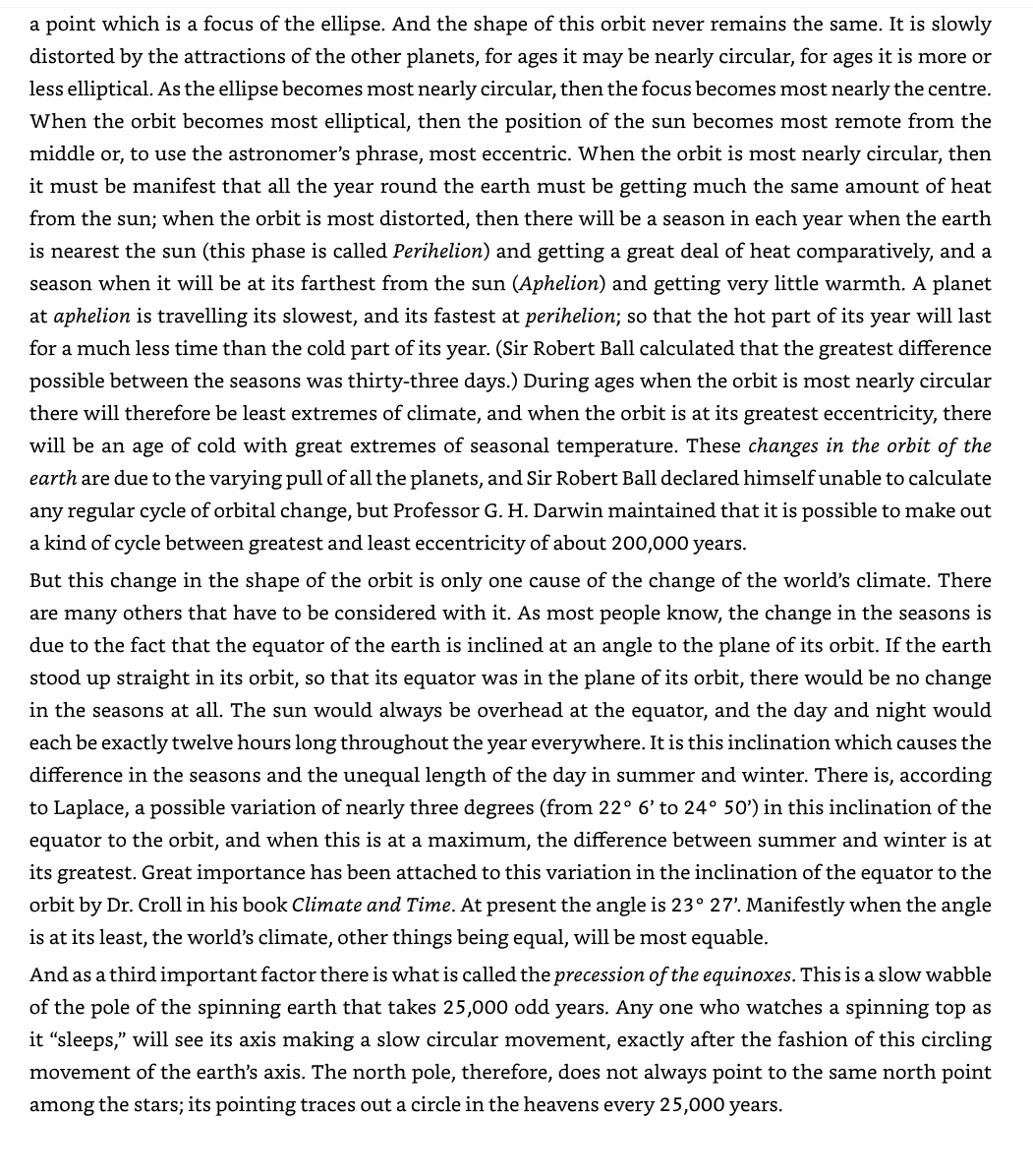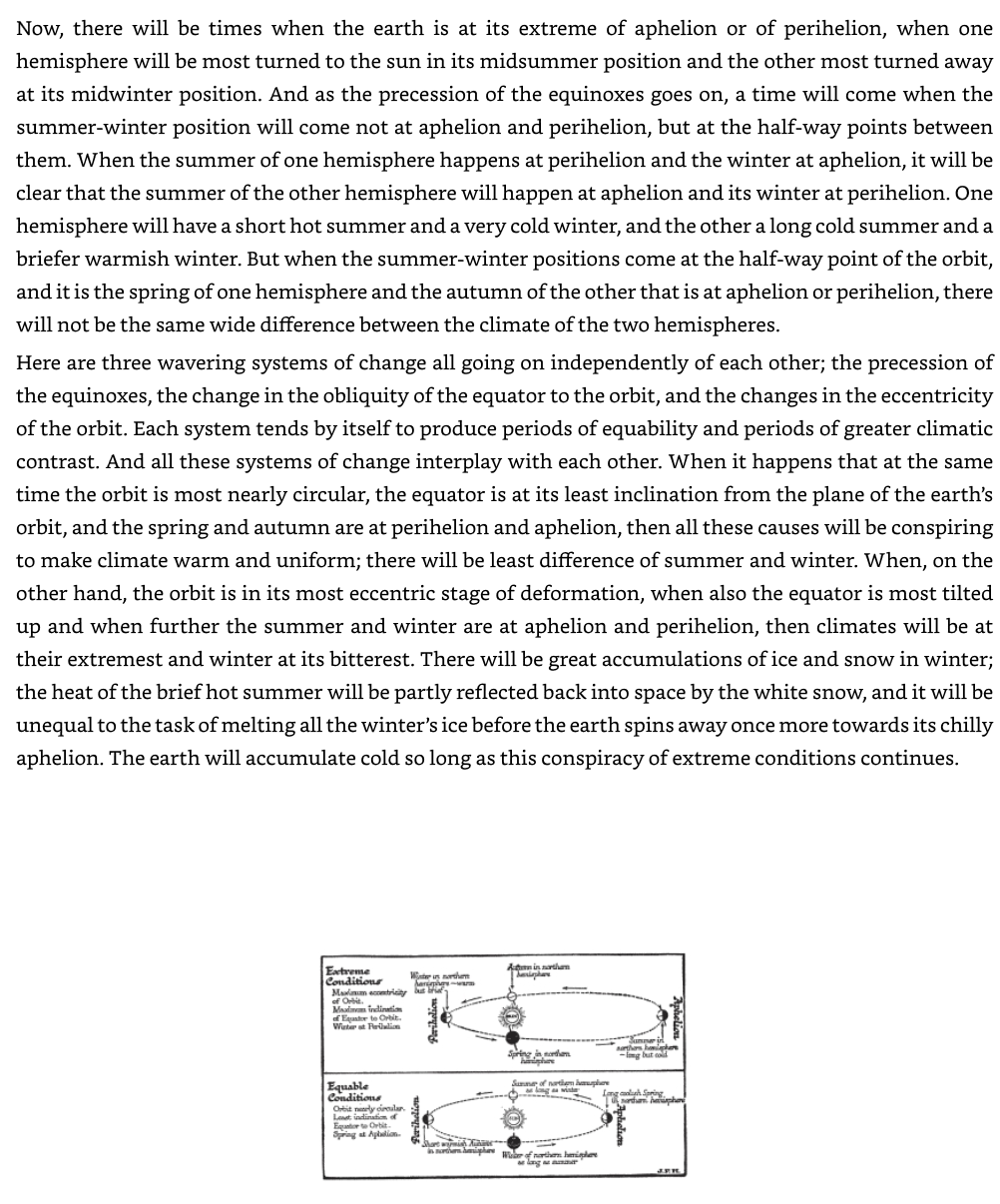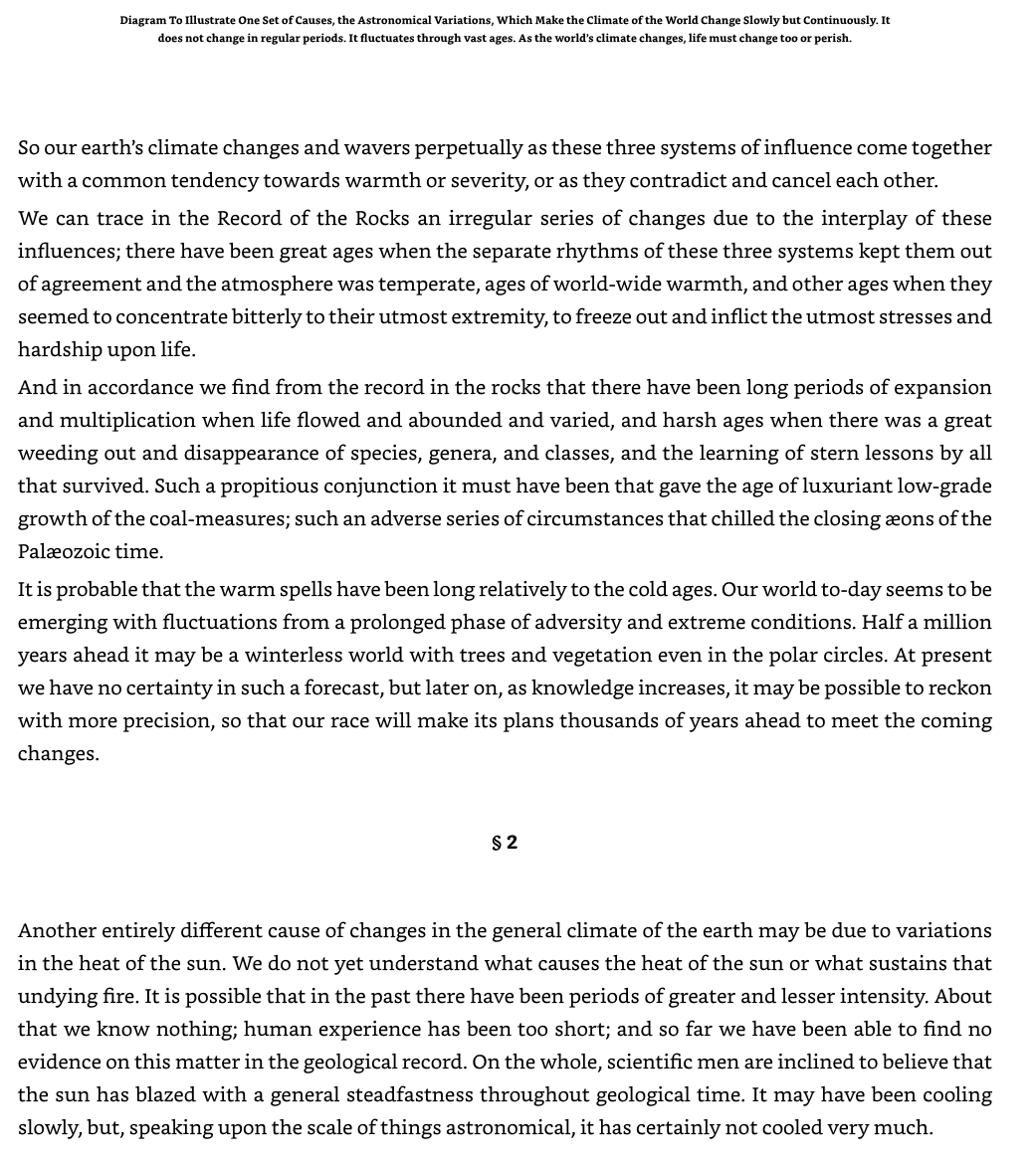“CHANGES IN THE WORLD’S CLIMATE
A complete account of the causes of these great climatic fluctuations has still to be worked out, but we may perhaps point out some of the chief of them. Prominent among them is the fact that the earth does not spin in a perfect circle round the sun. Its path or orbit is like a hoop that is distorted; it is, roughly speaking, elliptical (ovo-elliptical), and the sun is nearer to one end of the ellipse than the other. It is a ta point which is a focus of the ellipse. And the shape of this orbit never remains the same. It is slowly distorted by the attractions of the other planets, for ages it may be nearly circular, for ages it is more or less elliptical. As the ellipse becomes most nearly circular, then the focus becomes most nearly the centre.
When the orbit becomes most elliptical, then the position of the sun becomes most remote from the middle or, to use the astronomer’s phrase, most eccentric. When the orbit is most nearly circular, then it must be manifest that all the year round the earth must be getting much the same amount of heat from the sun; when the orbit is most distorted, then there will be a season in each year when the earth is nearest the sun (this phase is called Perihelion) and getting a great deal of heat comparatively, and a season when it will be at its farthest from the sun (Aphelion) and getting very little warmth. A planet at aphelion is travelling its slowest, and its fastest at perihelion; so that the hot part of its year will last for a much less time than the cold part of its year. (Sir Robert Ball calculated that the greatest difference possible between the seasons was thirty-three days.) During ages when the orbit is most nearly circular there will therefore be least extremes of climate, and when the orbit is at its greatest eccentricity, there will be an age of cold with great extremes of seasonal temperature. These changes in the orbit of the earth are due to the varying pull of all the planets, and Sir Robert Ball declared himself unable to calculate any regular cycle of orbital change, but Professor G. H. Darwin maintained that it is possible to make out a kind of cycle between greatest and least eccentricity of about 200,000 years.But this change in the shape of the orbit is only one cause of the change of the world’s climate. There are many others that have to be considered with it. As most people know, the change in the seasons is due to the fact that the equator of the earth is inclined at an angle to the plane of its orbit. If the earth stood up straight in its orbit, so that its equator was in the plane of its orbit, there would be no change in the seasons at all. The sun would always be overhead at the equator, and the day and night would each be exactly twelve hours long throughout the year everywhere. It is this inclination which causes the difference in the seasons and the unequal length of the day in summer and winter. There is, according to Laplace, a possible variation of nearly three degrees (from 22° 6’ to 24° 50’) in this inclination of the equator to the orbit, and when this is at a maximum, the difference between summer and winter is at its greatest. Great importance has been attached to this variation in the inclination of the equator to the orbit by Dr. Croll in his book Climate and Time. At present the angle is 23° 27’. Manifestly when the angle is at its least, the world’s climate, other things being equal, will be most equable.
And as a third important factor there is what is called the precession of the equinoxes. This is a slow wobble of the pole of the spinning earth that takes 25,000 odd years. Any one who watches a spinning top as it “sleeps,” will see its axis making a slow circular movement, exactly after the fashion of this circling movement of the earth’s axis. The north pole, therefore, does not always point to the same north point among the stars; its pointing traces out a circle in the heavens every 25,000 years.”
The Project Gutenberg eBook of The Outline of History, by H. G. Wells.










Full account of the influences which are actually relevant to climate. Carbon dioxide and the mythical ‘greenhouse effect’ are conspicuous by their absence. The effect of moisture is to cool the surface, this is correct, through the effect of clouds and reduction in lapse rate, again nothing to do with the ‘greenhouse effect’.
How refreshing to read an account written back in the days when people wrote to inform, rather to impress, in stark contrast to the pretentious goobledegook which characterizes so much modern science.
‘rather than to impress’
In The Purchase of the North Pole (Topsy Turvy), written by Jules Verne in 1889, a solution to the problem is proposed!
“The operation which is being tried by President Barbicane and Capt. Nicholl is as follows:
“The production of a recoil, on the 22d of September, at midnight, by means of a cannon a million times larger in volume than the cannon of twenty-seven centimetres, throwing a projectile of 180,000 tons, with a powder giving it a velocity of 2,800 kilometres.
Now, if this shooting takes place below the equatorial line, nearly on the thirty-fourth degree of latitude west of the meridian of Paris, at the foot of Kilimanjaro, and if it is directed towards the south, these are the mechanical effects which it will have on the earth’s sphere: Instantly, in consequence of the shock acting with the daily movement a new axis will be formed and, as the old axis will be displaced to the amount of twenty-three degrees and twenty-eight minutes, according to the figures obtained by J.T. Maston, the new axis will be perpendicular to the direction of the ecliptic.”
The claim that the orbit related differences between the seasons could be up to 33 days
is quiet number,which could explain so many things
without the use of unicorns,goblins or even worse, Co2.